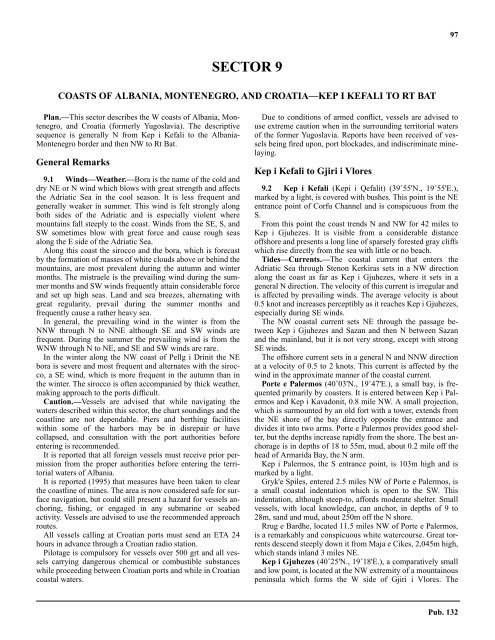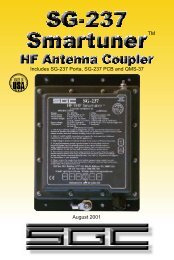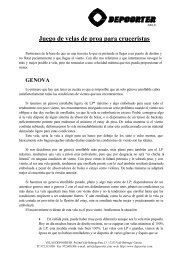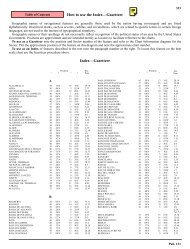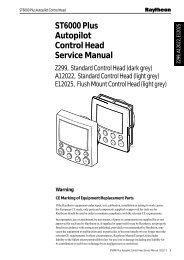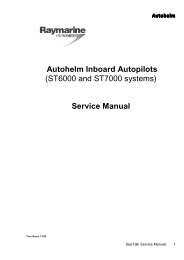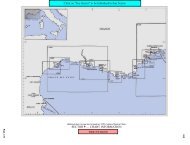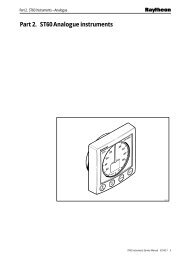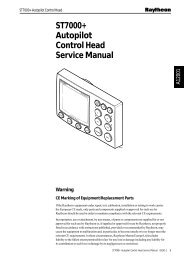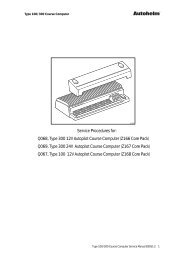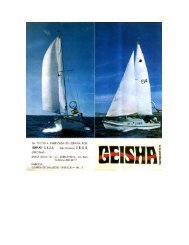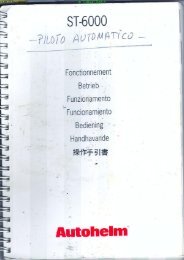Create successful ePaper yourself
Turn your PDF publications into a flip-book with our unique Google optimized e-Paper software.
97SECTOR 9COASTS OF ALBANIA, MONTENEGRO, AND CROATIA—KEP I KEFALI TO RT BAT9.0 Plan.—This sector describes the W coasts of Albania, Montenegro,and Croatia (formerly Yugoslavia). The descriptivesequence is generally N from Kep i Kefali to the Albania-Montenegro border and then NW to Rt Bat.General Remarks9.1 Winds—Weather.—Bora is the name of the cold anddry NE or N wind which blows with great strength and affectsthe Adriatic Sea in the cool season. It is less frequent andgenerally weaker in summer. This wind is felt strongly alongboth sides of the Adriatic and is especially violent wheremountains fall steeply to the coast. Winds from the SE, S, andSW sometimes blow with great force and cause rough seasalong the E side of the Adriatic Sea.9.1 Along this coast the sirocco and the bora, which is forecastby the formation of masses of white clouds above or behind themountains, are most prevalent during the autumn and wintermonths. The mistraele is the prevailing wind during the summermonths and SW winds frequently attain considerable forceand set up high seas. Land and sea breezes, alternating withgreat regularity, prevail during the summer months andfrequently cause a rather heavy sea.9.1 In general, the prevailing wind in the winter is from theNNW through N to NNE although SE and SW winds arefrequent. During the summer the prevailing wind is from theWNW through N to NE, and SE and SW winds are rare.9.1 In the winter along the NW coast of Pellg i Drinit the NEbora is severe and most frequent and alternates with the sirocco,a SE wind, which is more frequent in the autumn than inthe winter. The sirocco is often accompanied by thick weather,making approach to the ports difficult.9.1 Caution.—Vessels are advised that while navigating thewaters described within this sector, the chart soundings and thecoastline are not dependable. Piers and berthing facilitieswithin some of the harbors may be in disrepair or havecollapsed, and consultation with the port authorities beforeentering is recommended.9.1 It is reported that all foreign vessels must receive prior permissionfrom the proper authorities before entering the territorialwaters of Albania.9.1 It is reported (1995) that measures have been taken to clearthe coastline of mines. The area is now considered safe for surfacenavigation, but could still present a hazard for vessels anchoring,fishing, or engaged in any submarine or seabedactivity. Vessels are advised to use the recommended approachroutes.9.1 All vessels calling at Croatian ports must send an ETA 24hours in advance through a Croatian radio station.9.1 Pilotage is compulsory for vessels over 500 grt and all vesselscarrying dangerous chemical or combustible substanceswhile proceeding between Croatian ports and while in Croatiancoastal waters.9.1 Due to conditions of armed conflict, vessels are advised touse extreme caution when in the surrounding territorial watersof the former Yugoslavia. Reports have been received of vesselsbeing fired upon, port blockades, and indiscriminate minelaying.Kep i Kefali to Gjiri i Vlores9.2 Kep i Kefali (Kepi i Qefalit) (39˚55'N., 19˚55'E.),marked by a light, is covered with bushes. This point is the NEentrance point of Corfu Channel and is conspicuous from theS.9.2 From this point the coast trends N and NW for 42 miles toKep i Gjuhezes. It is visible from a considerable distanceoffshore and presents a long line of sparsely forested gray cliffswhich rise directly from the sea with little or no beach.9.2 Tides—Currents.—The coastal current that enters theAdriatic Sea through Stenon Kerkiras sets in a NW directionalong the coast as far as Kep i Gjuhezes, where it sets in ageneral N direction. The velocity of this current is irregular andis affected by prevailing winds. The average velocity is about0.5 knot and increases perceptibly as it reaches Kep i Gjuhezes,especially during SE winds.9.2 The NW coastal current sets NE through the passage betweenKep i Gjuhezes and Sazan and then N between Sazanand the mainland, but it is not very strong, except with strongSE winds.9.2 The offshore current sets in a general N and NNW directionat a velocity of 0.5 to 2 knots. This current is affected by thewind in the approximate manner of the coastal current.9.2 Porte e Palermos (40˚03'N., 19˚47'E.), a small bay, is frequentedprimarily by coasters. It is entered between Kep i Palermosand Kep i Kavadonit, 0.8 mile NW. A small projection,which is surmounted by an old fort with a tower, extends fromthe NE shore of the bay directly opposite the entrance anddivides it into two arms. Porte e Palermos provides good shelter,but the depths increase rapidly from the shore. The best anchorageis in depths of 18 to 55m, mud, about 0.2 mile off thehead of Armarida Bay, the N arm.9.2 Kep i Palermos, the S entrance point, is 103m high and ismarked by a light.9.2 Gryk'e Spiles, entered 2.5 miles NW of Porte e Palermos, isa small coastal indentation which is open to the SW. Thisindentation, although steep-to, affords moderate shelter. Smallvessels, with local knowledge, can anchor, in depths of 9 to28m, sand and mud, about 250m off the N shore.9.2 Rrug e Bardhe, located 11.5 miles NW of Porte e Palermos,is a remarkably and conspicuous white watercourse. Great torrentsdescend steeply down it from Maja e Cikes, 2,045m high,which stands inland 3 miles NE.9.2 Kep i Gjuhezes (40˚25'N., 19˚18'E.), a comparatively smalland low point, is located at the NW extremity of a mountainouspeninsula which forms the W side of Gjiri i Vlores. ThePub. 132


